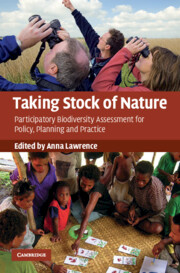Book contents
- Frontmatter
- Contents
- List of contributors
- Acknowledgements
- 1 Introduction: learning from experiences of participatory biodiversity assessment
- 2 Monitoring and assessment of biodiversity under the Convention on Biological Diversity and other international agreements
- 3 The Millennium Ecosystem Assessment: a multi-scale assessment for global stakeholders
- 4 Conservation of biological diversity in El Salvador shade coffee: the importance of taxonomic capacity for participatory assessments
- 5 Taking stock of nature in species-rich but economically poor areas: an emerging discipline of locally based monitoring
- 6 Researching local perspectives on biodiversity in tropical landscapes: lessons from ten case studies
- 7 Participatory resources monitoring in SW China: lessons after five years
- 8 Forest inventory in Nepal – technical power or social empowerment?
- 9 Perceptions of landscape change in British Columbia's Northwest: implications for biodiversity and participatory management
- 10 How thousands planned for a billion: lessons from India on decentralized, participatory planning
- 11 Inside monitoring: a comparison of bird monitoring groups in Slovenia and the United Kingdom
- 12 The personal and political of volunteers' data: towards a national biodiversity database for the UK
- 13 Improving forest management through participatory monitoring: a comparative case study of four community-based forestry organizations in the Western United States
- Index
- References
11 - Inside monitoring: a comparison of bird monitoring groups in Slovenia and the United Kingdom
Published online by Cambridge University Press: 06 December 2010
- Frontmatter
- Contents
- List of contributors
- Acknowledgements
- 1 Introduction: learning from experiences of participatory biodiversity assessment
- 2 Monitoring and assessment of biodiversity under the Convention on Biological Diversity and other international agreements
- 3 The Millennium Ecosystem Assessment: a multi-scale assessment for global stakeholders
- 4 Conservation of biological diversity in El Salvador shade coffee: the importance of taxonomic capacity for participatory assessments
- 5 Taking stock of nature in species-rich but economically poor areas: an emerging discipline of locally based monitoring
- 6 Researching local perspectives on biodiversity in tropical landscapes: lessons from ten case studies
- 7 Participatory resources monitoring in SW China: lessons after five years
- 8 Forest inventory in Nepal – technical power or social empowerment?
- 9 Perceptions of landscape change in British Columbia's Northwest: implications for biodiversity and participatory management
- 10 How thousands planned for a billion: lessons from India on decentralized, participatory planning
- 11 Inside monitoring: a comparison of bird monitoring groups in Slovenia and the United Kingdom
- 12 The personal and political of volunteers' data: towards a national biodiversity database for the UK
- 13 Improving forest management through participatory monitoring: a comparative case study of four community-based forestry organizations in the Western United States
- Index
- References
Summary
Throughout the member states of the European Union a large number of volunteers work alone on biodiversity monitoring across a range of species and habitats. They send their records to electronic databases via nature-based websites and sometimes talk to one another via discussion boards. One recently established example is the UK phenology network (http://www.phenology.org.uk). However, most volunteer monitoring programmes are embedded in the many and varied nature-based organizations in Europe, in particular those associations dedicated to members' interest in specific taxonomic groups of flora and fauna.
Our chapter explores the contribution these organizations make to monitoring biodiversity by focusing on two case studies of highly productive ornithological associations – the regional Northumberland and Tyneside Bird Club (NTBC) operating at the county level in the north-east of England and the Birdwatching and Bird Study Association of Slovenia (Društvo za opazovanje in proučevanje ptic – DOPPS), a national organization.
The two organizations show similarities and differences. DOPPS is a relatively young organization, with strong links to the global environmental NGO, BirdLife International, which unites over 2 500 000 members of different bird organizations worldwide, with more than 4000 staff working on conservation projects (BirdLife, 2007). DOPPS has carved out an influential position in the field of environmental governance within the small, newly emerged nation state of Slovenia. NTBC is an older, county level (i.e. sub-national) organization.
- Type
- Chapter
- Information
- Taking Stock of NatureParticipatory Biodiversity Assessment for Policy, Planning and Practice, pp. 232 - 250Publisher: Cambridge University PressPrint publication year: 2010
References
- 6
- Cited by

